Birdfinding.info ⇒ The Yellow-crested Cockatoo is a charismatic species which has been heavily persecuted for the illegal cagebird trade to the point that it has been declared critically endangered. Its range in recent times was quite large, encompassing most of Sulawesi and several other substantial islands, and it is conceivable that small but viable populations may yet persist undetected (or just unreported) in isolated areas, but its known populations have declined precipitously, and many have vanished. The remnant native population most often seen by tourists is protected, but declining, in Indonesia’s Komodo National Park. Another area where it can sometimes be found is the central hill country of Timor (both countries). Hong Kong’s large introduced population represents an insurance policy against extinction. It is readily found in the vicinity of Hong Kong Park and the nearby zoo and botanical garden. Members of the small Singapore population can often be found at West Coast and Labrador Parks. (For the distinct form or closely related species endemic to Sumba Island, see “Citron-crested Cockatoo”.)
Yellow-crested Cockatoo
Cacatua sulphurea
Endemic to Sulawesi, the Lesser Sundas from Penida to Timor, and a few outlying islands. Relentless trapping for the illegal pet trade has depleted its populations to point that it has been extirpated from most of its historical range and has been declared critically endangered.
Two distinct forms are generally recognized, and increasingly regarded as separate species:
“Yellow-crested Cockatoo” (sulphurea): the nominate form on Sulawesi and nearby island groups to the south, including Kabaena, Muna, Butung, and the Tanahjampea and Tukangbesi Islands (populations of the latter two archipelagos have been proposed as separate subspecies: djampeana and paulandrewi, respectively); parvula on the Lesser Sundas from Penida to Timor (populations from Penida to Alor have been proposed as a separate subspecies: occidentalis); and abbotti, a tiny isolated western population on Masalembu Besar Island in the Java Sea.
“Citron-crested Cockatoo” (citrinocristata): on Sumba Island—as of 2021 The Handbook of the Birds of the World and BirdLife International recognize this form as a species.
The Yellow-crested Cockatoo has been extirpated from most of its extensive recent historical range, and an unknown number of small relict populations remain in scattered pockets, perhaps mostly uncatalogued. The Indonesian government has adopted an intensive conservation policy to protect many bird populations, so detailed information is not forthcoming. The following summary is drawn from openly available, published sources.
On Sumba Island, the “Citron-crested” form declined from an estimated 3,200 in 1992 to around 560 in 2012, but some localized increases have been noted. Reportedly the second largest population is on Komodo Island, where about 500 individuals remain under the protection of Komodo National Park.
A 2016 study estimated potentially viable populations of: 220-360 on Timor (most in Timor-Leste); 200-300 on Sulawesi; 140-170 on Rinca and Flores; 50-100 on Sumbawa. On Tanahjampea, the population was estimated at <100 in 2015. A small population may persist on Alor (based on a flock of ~18 observed in 2009).
Additional tiny populations of about twenty or fewer have been found in the 2000s on Kadatua (west of Buton), Lintea Selatan (beside Tomea), Masakambing (the last remnants of abbotti), Oroho (beside Wangi Wangi), Pantar, Roti (beside Timor), and the Tukangbesi Islands.
An introduced population has been established in Hong Kong since the mid-1900s. As of 2020, it numbered approximately 120-130 and was generally increasing.

Another day at the office park for Yellow-crested Cockatoos of Hong Kong’s introduced urban population. (April 19, 2021.) © Eric Wong
A smaller introduced population appears more tenuously established in Singapore. A still-smaller feral flock is known from the Taoyuan-Taipei area of Taiwan.
Identification
A mid-sized white cockatoo with a yellow crest, nearly identical in all but size to the larger, better-known Sulphur-crested Cockatoo. (For a detailed comparison of the several similar forms in this complex, see Identification of Yellow-crested Cockatoos.)
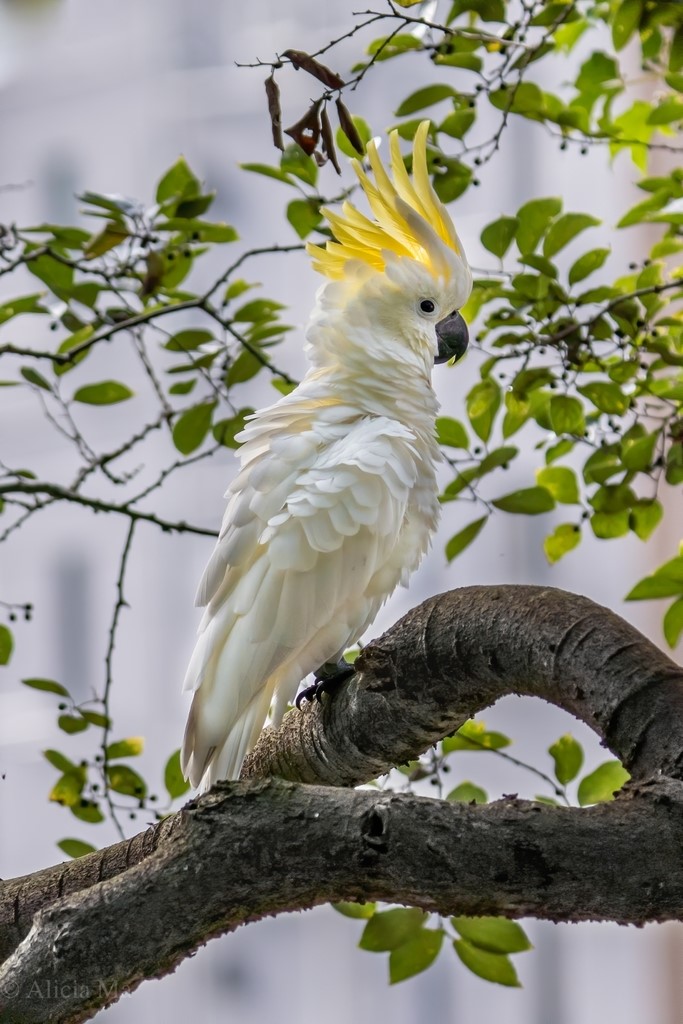
Yellow-crested Cockatoo, male with crest raised to maximum aesthetic advantage. (Hong Kong; September 14, 2020.) © Alicia Ma
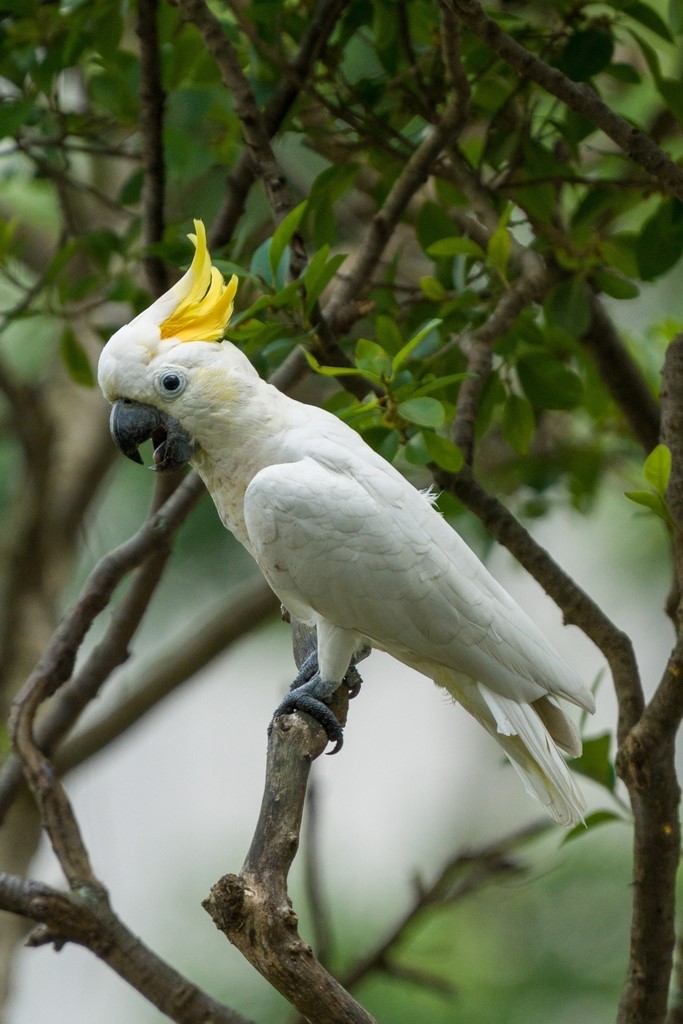
Yellow-crested Cockatoo, male showing yellowish cheek patch. (Hong Kong; September 13, 2019.) © Oscar Ho
As on Sulphur-crested, the frontal feathers of the crest are white, and the middle and hind-crown feathers are yellow, long, and up-curved—so their tips point forward when the crest is raised. At rest, the white shield partly obscures the yellow feathers. The yellow coloration varies somewhat from pale sulphur to more vivid shades of yellow (and apricot-orange on the “Citron-crested” form on Sumba Island).
Yellow-crested usually shows a yellowish patch on the cheeks or ear-coverts—but this feature varies and is often be too subtle to detect consistently.
The orbital skin is white, which is what conveys its unnaturally big-eyed impression and distinguishes it from the “Triton Cockatoo” (i.e., the New Guinean form of Sulphur-crested), which typically has bluish orbital skin.

Yellow-crested Cockatoo, male with crest flattened. (Hong Kong; July 1, 2017.) © Catalina Tong

Yellow-crested Cockatoo, male and female at nest—the female has red eyes and a smaller bill. (Hong Kong; February 26, 2021.) © Paul Dickson

Yellow-crested Cockatoo, showing proportionately large bill. (Hong Kong; March 16, 2020.) © Oscar Ho
As in other white cockatoos, the undersides of the wings and tail are suffused with yellow. The breast and belly often have a yellowish wash.
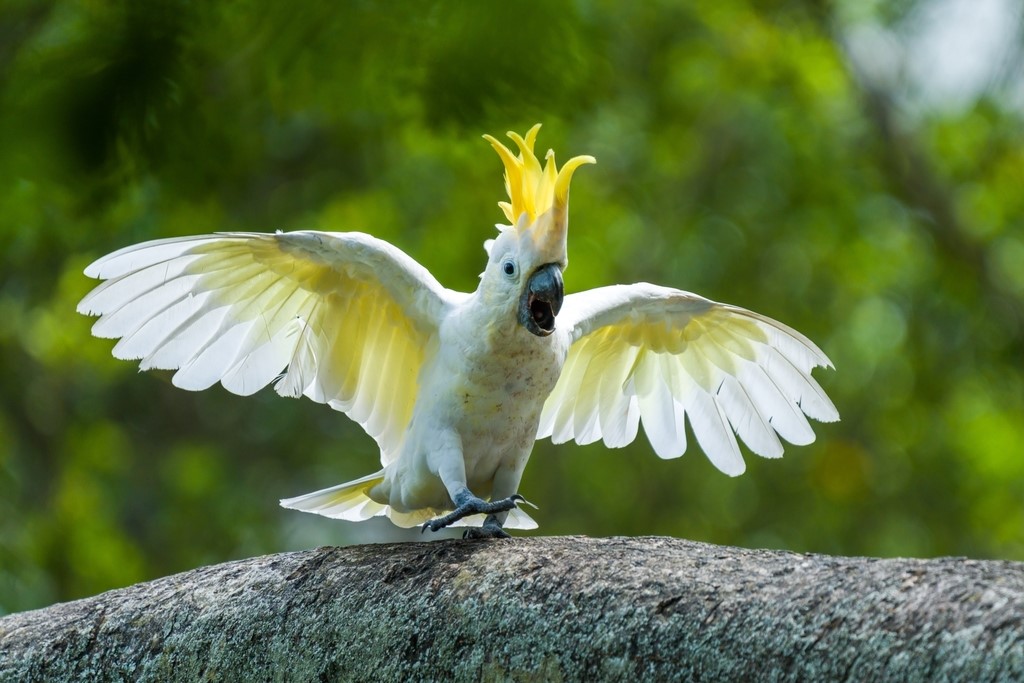
Yellow-crested Cockatoo, male with crest fully extended and wings spread, apparently strutting around like a mad king, and showing yellowish wash on underwings, undertail, and breast. (Hong Kong; September 13, 2019.) © Oscar Ho
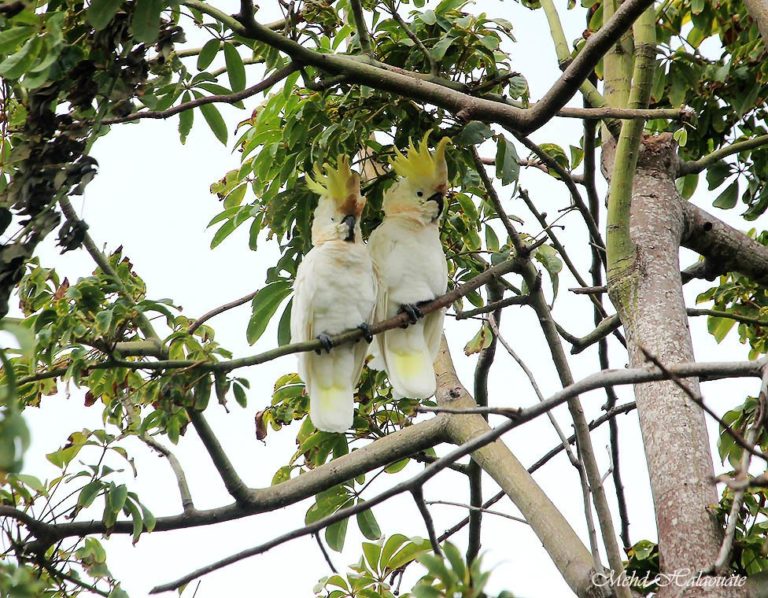
Yellow-crested Cockatoo, C. s. abbotti—a peculiar, isolated subspecies, which is the largest overall and has the longest crest feathers—note that its total remaining wild population was about 13 individuals when this photo was taken, following a small increase from the high single digits. (Masakambing Island, Masalembu Archipelago, Indonesia; June 2012.) © Mehd Halaouate
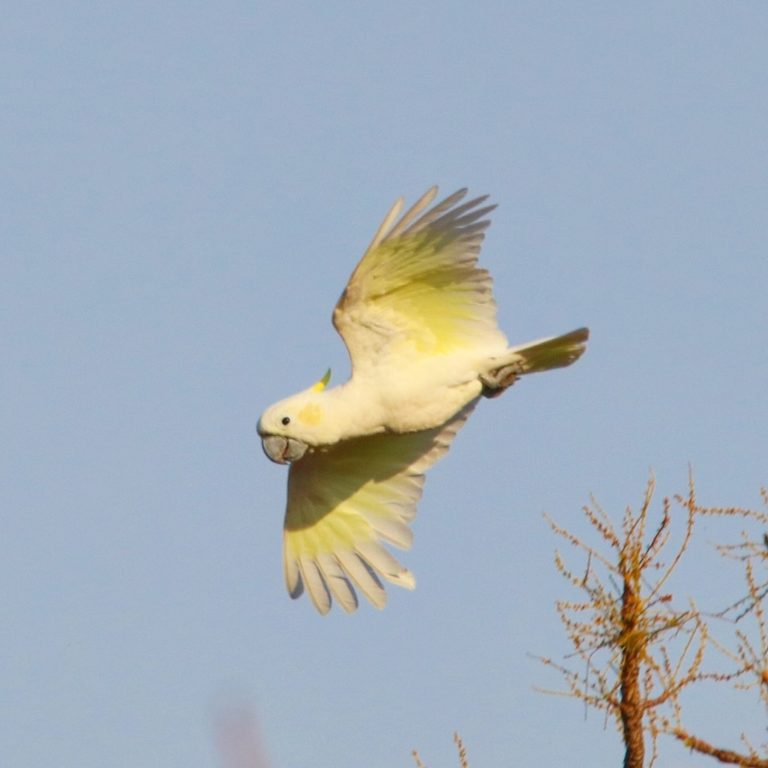
Yellow-crested Cockatoo, in flight, showing yellow cheek patch and wash on the undersides of wings. (Komodo Island, Nusa Tenggara Timur, Indonesia; September 2018.) © Tim Avery
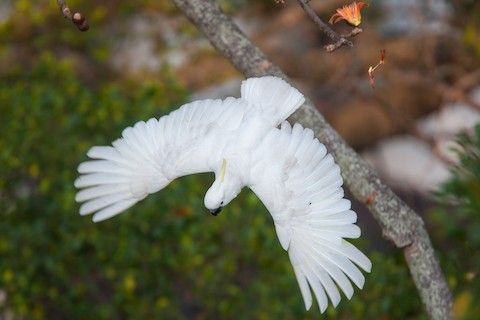
Yellow-crested Cockatoo, dorsal view in flight—appearing almost entirely white from this perspective. (Hong Kong Park, Hong Kong; March 9, 2008.) © Martti Siponen

“Citron-crested Cockatoo”, C. s. citrinocristata, showing apricot-orange crest. (Sumba, Indonesia; June 2009.) © James Eaton
“Citron-crested Cockatoo”. Like typical Yellow-crested, but with an apricot-orange crest. Otherwise, in all key measurements (bill, wing, tail, crest), “Citron-crested” apparently falls within the variation of “Yellow-crested” populations.
“Citron-crested” usually shows an orangish patch on the cheeks or ear-coverts—where typical Yellow-crested usually have a yellowish patch. Some individuals also show a smudgy orangish collar.
As in other white cockatoos, the undersides of the wings and tail are suffused with a yellowish wash—although on “Citron-crested” the tone often appears more orange or brownish.
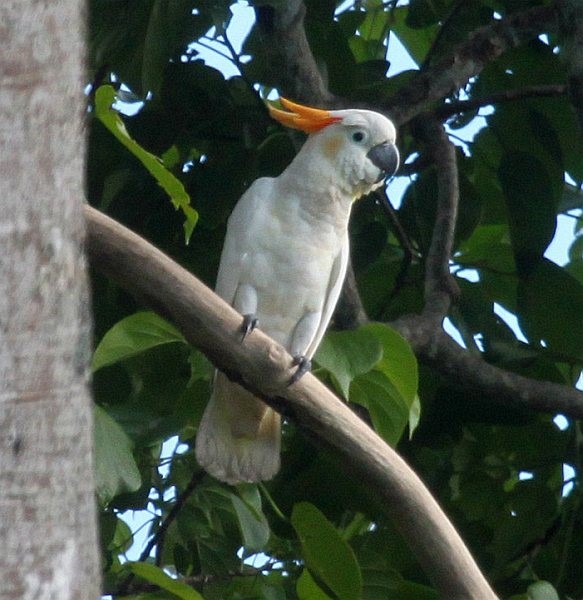
“Citron-crested Cockatoo”, C. s. citrinocristata, showing apricot-orange crest and cheek patch. (Manurara, Manupeu Tanadaru National Park, Sumba, Indonesia; January 26, 2013.) © Hanom Bashari
Voice. Typical calls are harsh screeches:
Bipolo, West Timor, Indonesia; October 8, 1995. © Filip Verbelen
Notes
Polytypic species consisting of four recognized subspecies, representing two distinct forms: “Yellow-crested Cockatoo” (sulphurea) and “Citron-crested Cockatoo” (citrinocristata), which the Handbook of the Birds of the World and BirdLife International recognized as a separate species in 2021. (This reclassification may be correct or at least justifiable, as it clearly advances important conservation goals, but taxonomically it seems to be a borderline judgment call.)
The “Yellow-crested” form alone (i.e., excluding “Citron-crested”) comprises three recognized subspecies plus three more that have been proposed. These are: sulphurea of Sulawesi and nearby island groups (with populations of the outlying Tanahjampea and Tukangbesi Islands proposed as separate subspecies: djampeana and paulandrewi, respectively); parvula of the Lesser Sundas from Penida to Timor (with populations from Penida to Alor proposed as a separate subspecies: occidentalis); and abbotti, a distinctive, isolated, and tiny population confined to Masalembu Besar Island in the Java Sea.
(Conjecturally, based on some outward appearances and ecological commonalities, it also seems possible that the “Triton Cockatoo” (Cacatua galerita triton, plus eleonora) is more closely related to Yellow-crested than to Sulphur-crested Cockatoo, as traditionally classified.)
IUCN Red List Status: Critically Endangered.
Additional Photos of Yellow-crested Cockatoo
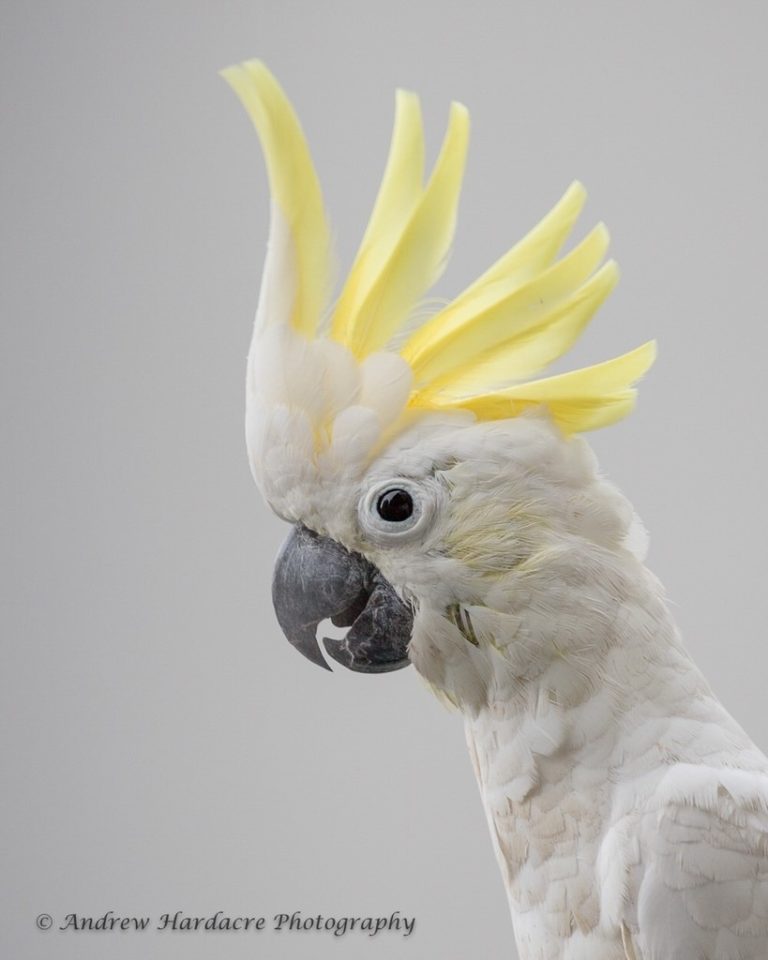
Yellow-crested Cockatoo, male. (Hong Kong; July 2018.) © Andrew Hardacre

Yellow-crested Cockatoo—a captive individual kept in a village. (Roti, Indonesia; December 20, 2004.) © Colin Trainor

Yellow-crested Cockatoo, male. (West Coast Park, Singapore; August 16, 2015.) © Mohit Kumar Ghatak
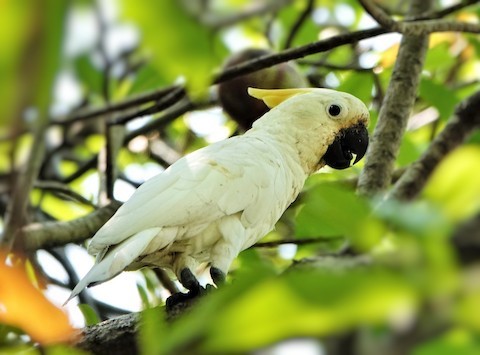
Yellow-crested Cockatoo, male. (Singapore.) © Norman Wu
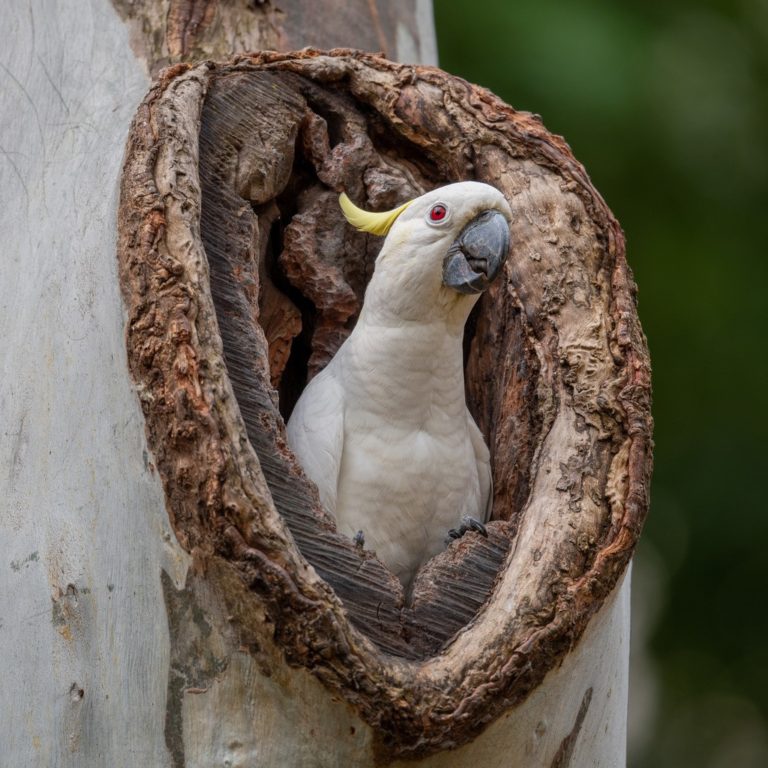
Yellow-crested Cockatoo, female in nest cavity. (Hong Kong; February 26, 2021.) © Paul Dickson
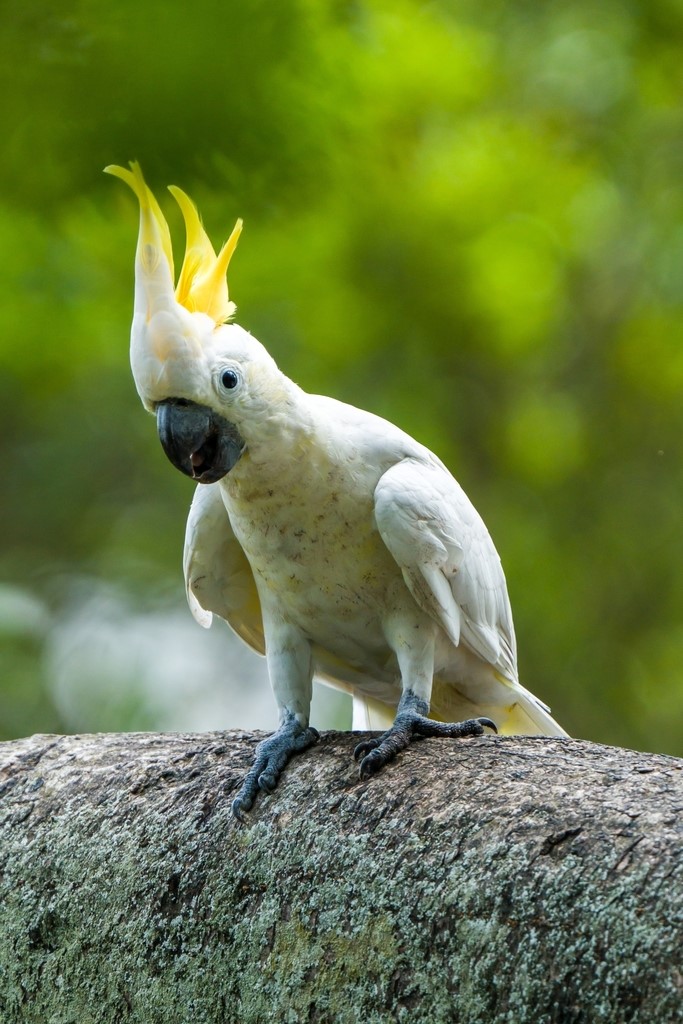
Yellow-crested Cockatoo, male. (Hong Kong; September 13, 2019.) © Oscar Ho

Yellow-crested Cockatoo, male. (Hong Kong; February 26, 2021.) © Paul Dickson

Yellow-crested Cockatoo, female eating a starfruit. (Singapore; July 31, 2016.) © scampisg
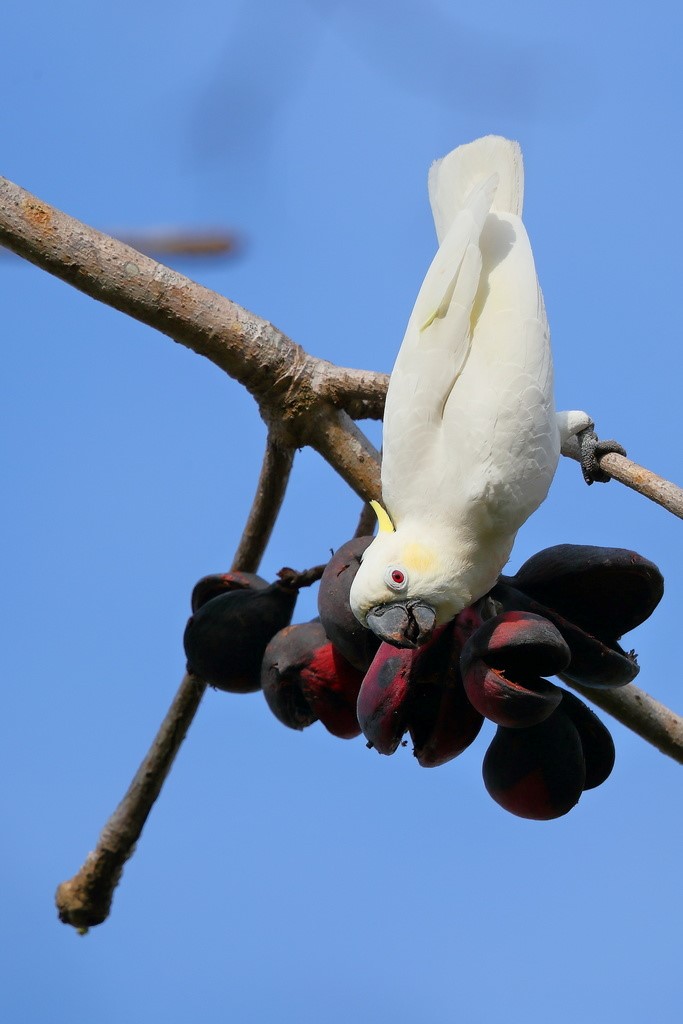
Yellow-crested Cockatoo, female. (Komodo Island, Nusa Tenggara Timur, Indonesia; July 2018.) © Carlos N.G. Bocos

Yellow-crested Cockatoo, male. (Komodo Island, Nusa Tenggara Timur, Indonesia; June 13, 2009.) © Ingo Waschkies
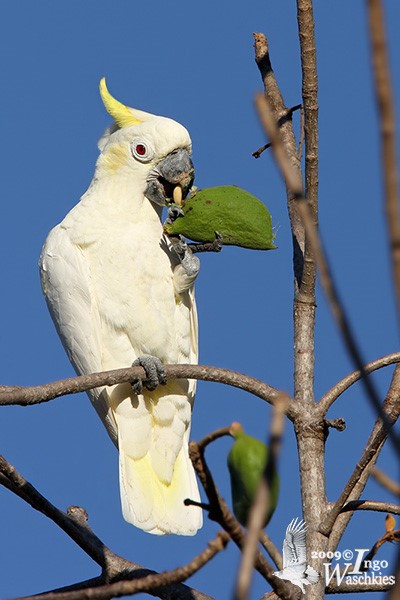
Yellow-crested Cockatoo, female. (Komodo Island, Nusa Tenggara Timur, Indonesia; June 13, 2009.) © Ingo Waschkies
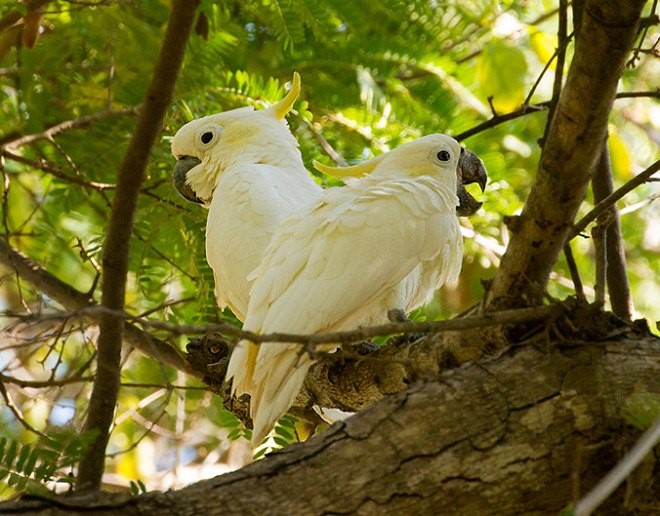
Yellow-crested Cockatoos. (Komodo Island, Nusa Tenggara Timur, Indonesia; July 29, 2015.) © Peter Ericsson
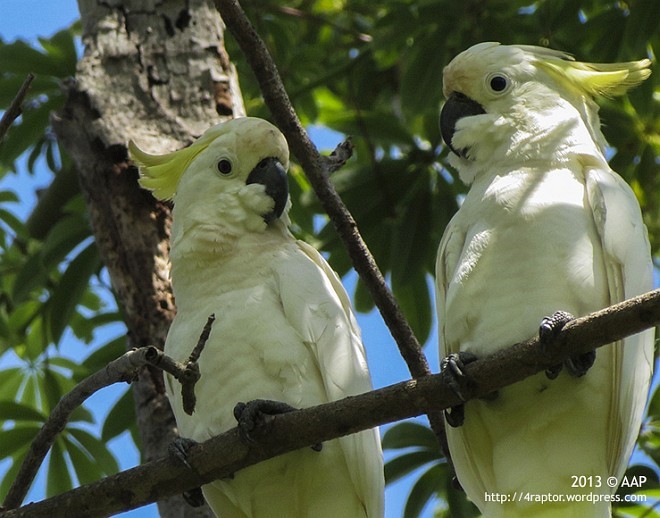
Yellow-crested Cockatoos, C. s. abbotti. (Masakambing Island, Masalembu Archipelago, Indonesia; June 8, 2013.) © Asman Adi Purwanto

Yellow-crested Cockatoo, C. s. abbotti. (Masakambing Island, Masalembu Archipelago, Indonesia; June 8, 2013.) © Asman Adi Purwanto
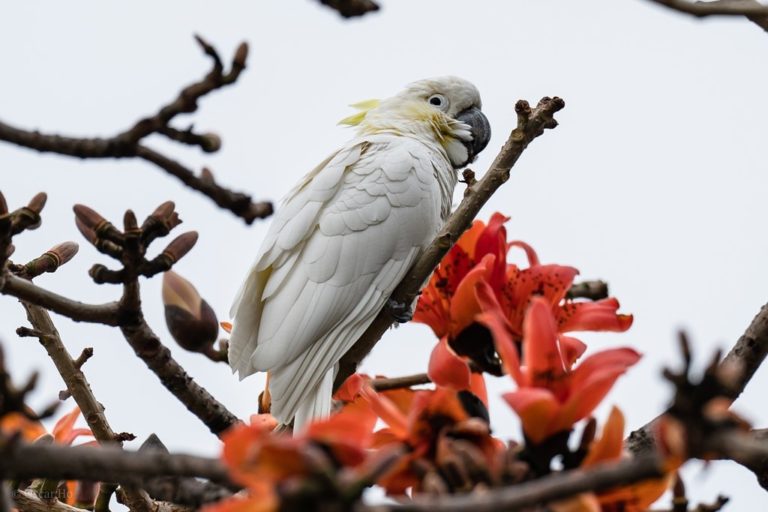
Yellow-crested Cockatoo. (Hong Kong; March 16, 2020.) © Oscar Ho
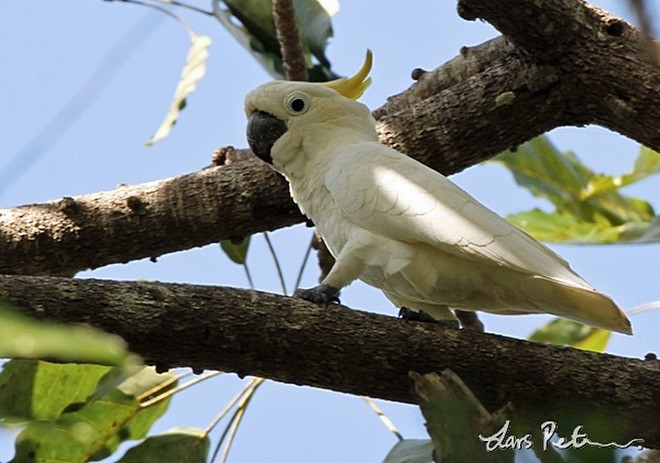
Yellow-crested Cockatoo, male. (Komodo Island, Nusa Tenggara Timur, Indonesia; August 10, 2010.) © Lars Petersson

Yellow-crested Cockatoo. (Komodo Island, Nusa Tenggara Timur, Indonesia; July 2009.) © James Eaton

Yellow-crested Cockatoo. (Komodo Island, Nusa Tenggara Timur, Indonesia; August 2012.) © James Eaton
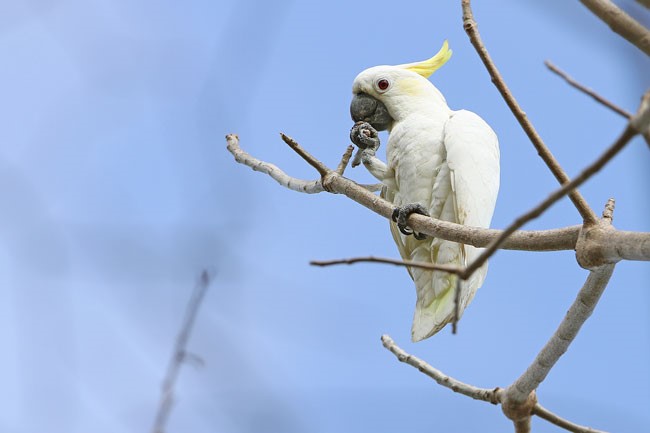
Yellow-crested Cockatoo. (Komodo Island, Nusa Tenggara Timur, Indonesia; September 2013.) © James Eaton
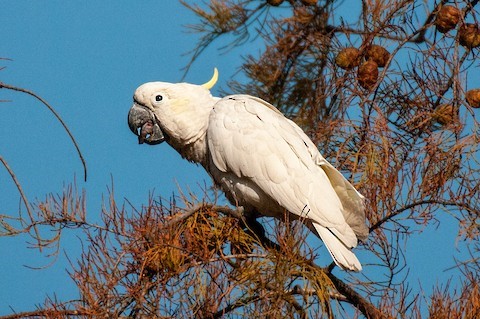
Yellow-crested Cockatoo. (Tsing Yi Park, Hong Kong; January 3, 2021.) © Kelvin NG

Yellow-crested Cockatoo. (Hong Kong; December 26, 2018.) © Qin Huang

Yellow-crested Cockatoo, ventral view in flight showing yellow wash on the undersides of the wings and tail. (Hong Kong; February 2021.) © Brian Kwok

Yellow-crested Cockatoo, ventral view in flight showing yellow wash on the undersides of the wings and tail. (Hong Kong Park, Hong Kong; January 5, 2019.) © Qin Huang

Yellow-crested Cockatoo, ventral view in flight showing yellow wash on the undersides of the wings and tail. (Bipolo, West Timor, Indonesia; July 2010.) © James Eaton

Yellow-crested Cockatoo. (Hong Kong Park, Hong Kong; March 15, 2015.) © Allison Miller
References
BirdLife International. 2018. Cacatua sulphurea. The IUCN Red List of Threatened Species 2018: e.T22684777A131874695. https://dx.doi.org/10.2305/IUCN.UK.2018-2.RLTS.T22684777A131874695.en. (Accessed August 27, 2021.)
BirdLife International. 2021. BirdLife’s Globally Threatened Bird Forums: Citron-crested Cockatoo (Cacatua citrinocristata): Revise global status? https://globally-threatened-bird-forums.birdlife.org/citron-crested-cockatoo-cacatua-citrinocristata-revise-global-status/. (Posted June 2, 2021. Accessed August 10, 2021.)
Cameron, M. 2007. Cockatoos. CSIRO Publishing, Collingwood, Victoria, Australia.
Collar, N.J., and S.J. Marsden. 2014. The subspecies of Yellow-crested Cockatoo Cacatua sulphurea. Forktail 30:23-27.
eBird. 2021. eBird: An online database of bird distribution and abundance. Cornell Lab of Ornithology, Ithaca, N.Y. http://www.ebird.org. (Accessed August 27, 2021.)
Forshaw, J.M. 2010. Parrots of the World. Princeton University Press.
Juniper, T., and M. Parr. 1998. Parrots: A Guide to Parrots of the World. Yale University Press.
Lin, R.S. and P.F. Lee. 2006. Status of Feral Populations of Exotic Cockatoos (Genus Cacatua) in Taiwan. Taiwania 51:188-194.
Michigan State University. 2021. AVoCet: Avian Vocalizations Center. https://avocet.integrativebiology.natsci.msu.edu/. (Accessed August 9, 2021.)
Mulawki, E.J. 2014. The Cockatoos: A Complete Guide to the 21 Species. McFarland Publishing, Jefferson, N.C.
Pyle, R.L., and P. Pyle. 2017. The Birds of the Hawaiian Islands: Occurrence, History, Distribution, and Status. Version 2 (January 1, 2017). http://hbs.bishopmuseum.org/birds/rlp-monograph/. B.P. Bishop Museum, Honolulu, Hawaii.
Wang, S., and L.M. Chu. 2021. Microhabitat characteristics related to seasonal roost switching: implications from a threatened and introduced cockatoo species in an urban landscape. Avian Research 12.
Xeno-Canto. 2021. Yellow-crested Cockatoo – Cacatua sulphurea. https://www.xeno-canto.org/species/Cacatua-sulphurea. (Accessed August 27, 2021.)

